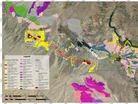KORE Mining hails Imperial Gold Project breakthroughs

KORE Mining has hailed breakthroughs with its Imperial Gold Project with the amount of outcrops, nuggets and anomalous gold far exceeding expectations.
Its 100% owned Imperial Project is located in California within nine miles of the Mesquite mine (owned by Equinox Gold), and KORE is forecasting US$343mn NPV5% post-tax with 44% IRR at US$1,450 per ounce, yielding 46,000 ounces gold a year over eight years.
CEO Scott Trebilcock said: "The exploration team delivered a step-change in geologic understanding, a key step in unlocking the potential for the Mesquite-Imperial-Picacho District to host multiple gold discoveries similar to Mesquite and Imperial. With a large number of pending assays and ongoing analyses, we expect more news in the coming weeks and months."
2022 Plans and Objectives
- Complete additional target definition drilling with person-portable drill
- Focus additional mapping and sampling on Powerline, Mesquite East and Ogilby targets to:
- Prioritise drill order for pending drill permit application (permit expected in H2 2022)
- Develop drill locations to support additional drill permit application in mid-2022
- Complete infill IP geophysics program to refine fault and structural geologic models
KORE has now defined five high priority target zones on the District: Mesquite East, Ogilby, Powerline, Sandwich and Acacia zones which all lie along the regionally extensive Copper Basin thrust fault. Future sampling, mapping, scout back-pack drilling, geophysics and other exploration techniques are expected to further define these target areas with 141 assays pending from the lab.
Imperial is a large, near surface oxide gold deposit with potential for open pit mining and cyanide heap leaching. The proposed project concept is similar to other mines in the area, namely the closed Picacho and operating Mesquite Mine. Heap leach processing has lower water, air, environmental and biological impact than milling operations.
In 2021, KORE's exploration team collected 259 rock samples and 293 stream sediment samples. Samples collected averaged 4kgs and were taken at an average depth of 0.4m below surface.
Of the 703 stream samples taken so far, 435 assayed over the gold detection limit of 5 parts per bn and 16 assayed over 100 parts per bn (0.1 g/t) with 24 samples still pending. In addition, of the 345 rock samples taken, 45 have assayed over 100 parts per bn (0.1 g/t) with 117 samples still pending.
- How is Anglo American Enhancing Mining Safety?Operations
- Anglo American and Teck: Forming a Global Minerals GiantSupply Chain & Operations
- Maaden Appoints Donovan Waller to Lead Mining Tech FutureTechnology
- The Future of Mining? Rio Tinto’s Game-Changing RestructureSupply Chain & Operations



